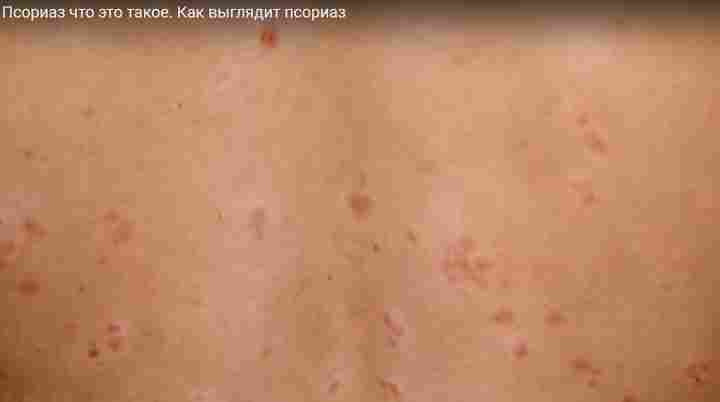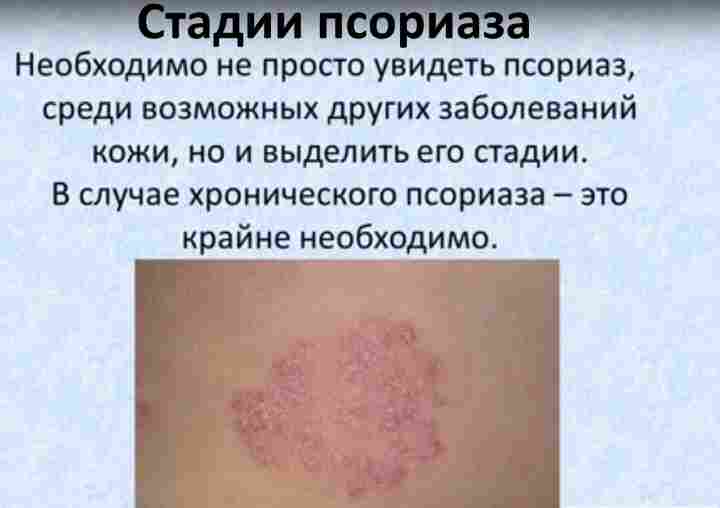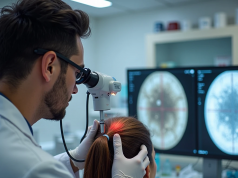Psoriasis is the same age as the human race, it would seem that we should know everything about it, but, no. The disease contains a huge number of "white spots". And it is at doctors, and most patients do not even realize that their disease is not a fungus or bacterial infection. In fact, this ailment, is an abnormal reaction of the immune system, caused by causes that have not yet been clarified. Knowing the causes and symptoms of psoriasis will help patients suffering from this disease.
Article Content:
- What kind of disease is that?
- International Classification of Disease
- Stages of development
- Peculiarities of diagnostics
- Psoriasis, history from ancient Hellas to the present day, interesting facts
- A modern view of this skin disease
- Treatment methods
- Psoriasis treatment with folk remedies video
What kind of disease is that?

This disease has another name - scaly lichen, which is its vivid characteristic. The main manifestation of psoriasis is the formation of inflamed plaques of varying size and dislocation on the skin. They are covered with thick skin scales. The area of affection of mankind is quite wide - about 3.9-10.25% of the total population of the Earth suffer from this affliction. At the same time, statistics say - these numbers are steadily increasing.
.
Trying to cure psoriasis have been mentioned as far back as the chronicles of ancient Greece. Modern science is tightly engaged in this disease for about 150 years. Achievements in this area scientists have more than modest. Effective treatment of psoriasis is still not available to mankind, which makes the disease almost the most difficult problem of dermatology.
According to the current ideas of dermatologists, psoriasis is a complex systemic disease characterized by disorders of the immune system, against the background of metabolic failure and the presence of trophic disorders. All this leads to specific disorders of the skin.
According to the majority of modern dermatologists, scaly lichen is a violation of trophic and metabolic processes in the skin, which leads to a malfunction of all body systems. Two theories of the etiology of this disease are most popular: viral and genetic.
The genetic theory has many supporters. If there is a diseased person in the family, then one or another form of the disease is present in 55-85% his relatives. True, despite this, in a certain part of patients heredity of the manifestation of this disease could not be established. This group of patients had to be singled out in particular. In them, the main cause was recognized to be phenotypic rather than genetic.
The viral theory of psoriasis also has its supporters. It is confirmed by the detection of antibodies in the blood of patients, and "elementary cells" have also been found in their skin. According to the adherents of this hypothesis, the disease does not necessarily develop after infection, there must be other certain conditions for it.
Also, have the right to life and other versions of the appearance of psoriasis: metabolic, neurogenic, endocrine, etc. All of them are worthy of existence and study. To date, it is believed that the state of the nervous and endocrine systems, the work of gastrointestinal organs can not cause the disease. They only have a significant impact on the course of this disease.
For example, in liver pathologies, the quality of blood purification is significantly reduced, which provokes various skin diseases, including itchy lichen planus. Also, another inverse relationship has been established, this disease causes fatty liver dystrophy. Therefore, patients should avoid fatty foods and alcohol to avoid putting additional strain on the liver.
So, what is psoriasis - the question is still unanswered. But, work is ongoing, we will learn more and more and there is hope that in the near future the mysteries of this mysterious disease will be solved.
International Classification of Disease
Psoriasis can manifest itself in a wide variety of forms. For ease of orientation, a common classification has been used.
(ICD) International Classification System for Diseases has also included this disease in its registry. There have been 10 revisions of the international disease registry since the organization was founded, so ICD10 is usually used. The tenth revision was initiated in 1983 and was completed in 1987.
It is also included in the International Classification of Diseases (ICD). Today, the 10th revision of the international register of diseases is already in use, so the abbreviation ICD 10 is used. Work on the 10th revision of the International Classification of Diseases began in 1983 and was completed in 1987.
ICD 10 is a standardized assessment tool for use in health management and medicine to monitor all problems that are somehow related to the health of the population and to establish the prevalence of various diseases.
This tool can be used to compare morbidity and mortality data from different countries. This makes it possible to obtain statistical data with subsequent systematization of diagnostic information.
WHO ICD 10 members have assigned unique codes to each disease. In the latest version, alphanumeric codes have been adopted for easy digital storage.
All types of psoriasis listed in ICD 10 have their own code. Dermatology distinguishes the following types and forms of psoriasis:
Psoriasis common (synonyms: plaque, simple, vulgar). The code is L-40.0. There are about 90% patients with this form of the disease.
Symptoms:
Plaques raised above the unaltered skin surface.
Coating of the skin with white-gray scales.
The scales easily peel off, revealing inflamed red skin that is very sensitive to minor trauma, after which it bleeds. As the inflammatory process progresses, the plaques increase in size.
All types of psoriasis are listed in ICD 10, and each has a specific code assigned to it. In dermatology, the following forms and types of psoriasis are distinguished:
Reverse psoriasis
This form of the disease results in lesions of the skin folds (flexor surfaces). Code L83-4. Dermatosis is manifested on the skin folds in the form of smooth spots, less often they are minimally flaky. Friction causes trauma to the skin, which leads to deterioration of the condition. The condition is often aggravated by the presence of fungus or streptococcal infection.
Droplet psoriasis
This form is characterized by the formation of a large number of red or purple spots on the skin, shaped like water droplets. Code L4. All parts of the body can be affected, but usually it is the skin of the legs. It has been noted that it usually appears as a complication after sore throat, pharyngitis, and other streptococcal infections.
Pustular or exudative
This type of psoriasis is considered particularly severe. Code L1-3 and L 40.82. It is manifested by the appearance of pustules and blisters. The skin in the affected areas becomes swollen, red, inflamed, easily peeled off. When pustules are infiltrated by bacteria or fungi, their contents become purulent. Pustular psoriasis develops usually on the distal parts of the limbs. With a severe course of the disease can provoke a generalized process, with rashes all over the body.
Arthropathic psoriasis (psoriatic arthritis)
The main feature is the occurrence of inflammatory phenomena in the joints. In this case, it is possible to affect all types of joints, although in most cases it is the phalanges of fingers and toes. The ICD 10 code is L85. Less often there is a manifestation of the disease on the hip, shoulder and knee joints. The clinical development of the disease is very severe, can even lead to disability of the patient. This suggests that psoriasis can affect not only the skin, but also lead to systemic damage to the body, which causes disability, and sometimes even death of the patient. That is why it is so important to identify it in the early stages, preventing the disease from developing into severe forms.
Erythrodermic psoriasis
It is a rather rare form of the disease and has the code L85. Usually manifests itself generalized, the area affected is almost the entire surface of the skin. The course is aggravated by itching, swelling, pain. Poorly diagnosed in the early stages, is difficult to treat, which is very often has a temporary effect. After completing the medication, the symptoms return.
Psoriatic onychodystrophy
Nail psoriasis, coded L86. Pathologies occur on the nails, the appearance changes, they become thickened and brittle. A severe neglected form of the disease can lead to complete loss of the nail.
Classifying this disease distinguish not only types of disease, but also the degree of symptomatic manifestation of psoriasis:
limited - the disease affected no more than 20% of skin;
common - defeat exceeded 20%;
universal - the disease has covered almost the entire surface of the skin.
The most common, justifying its name, is disseminated psoriasis.
Stages of development

In the limited or disseminated form, the disease has three stages: progressive, stable, and regressive.
Characteristics of the progressive stage:
- existing plaques continue to grow;
- new rashes appear;
- new elements of the rash appear on scuffs and scratches;
- existing plaques are flaking profusely.
Features of the stationary stage:
- there are no new elements;
- flaking of the elements is moderate;
- there are no signs of elemental growth.
The presence of folds around the elements in the horny layer indicates the transition of the stationary stage of the disease to the regressive stage.
Regressive stage, characterized by:
- by reducing the intensity of the flaking;
- elements are less common;
- In place of psoriatic plaques, hyper- or hyporheic patches appear.
Scaly lichen is characterized by periodic exacerbations against the background of a long course.
On this basis, psoriasis is subdivided into:
- summer - main exacerbation in winter and fall:
- winter - exacerbation in summer and spring;
- Off-seasonal - the most severe type. There is no connection with the seasons, and there are practically no remission periods.
Peculiarities of diagnostics
Diagnosis of psoriasis is not difficult if its development occurs according to a typical clinical picture. But, this disease very often has symptoms more suitable for other pathologies.
Thus, Onychodystrophy psoriatic is often mistaken for fungal lesions of the nail, all external manifestations have similar signs. But, these are completely different diseases and the treatment required is quite different.
Even skin psoriasis can be diagnosed as a fungus by a non-specialist. Cutaneous mycoses have similar symptoms (flaky plaques are formed, etc.). Therefore, if there are suspicious symptoms on the nails or skin of the body, do not self-prescribe treatment with the help of pharmacy or folk remedies - the diagnosis should be made by a doctor! Otherwise, such "treatment", in case of error, will lead to aggravation of symptoms.
The dermatologist will first make a scraping and send the material for analysis. In the case of a fungus, this is easy to find out and the appearance of the material determines the type of fungus that caused the infection.
In most cases, the course of psoriasis is accompanied by the appearance of secondary infections, both fungal and bacterial. Therefore, the doctor, having detected new clinical manifestations (change in the color of plaques, the appearance of purulent discharge) will periodically take tests to detect infectious agents.
Diagnosis of psoriasis must take into account a cluster of phenomena called the psoriatic triad.
In the diagnostic process, a set of phenomena called the psoriatic triad plays a role. The phenomena are manifested sequentially when the rash element is scraped.
The psoriatic triad, manifestation
The scaly elements of the rash come off as "shavings" when scraped off.
Scraping off reveals a thin transparent film that has some similarities to polyethylene.
Damage to the film causes spot bleeding.
Diagnosis of psoriasis is performed by a dermatologist, To obtain a more accurate clinical picture, it may be necessary to consult other specialists: rheumatologist, gastroenterologist, surgeon, etc.
Psoriasis, history from ancient Hellas to the present day, interesting facts
Scalp has affected people at all times. Historical references have come down to us from ancient Greece. In those times, all skin diseases causing itching and flaking were called by one word "psora", which gave the name to this disease.
The Roman Cornelius Celsus was the first person to compile an extensive treatise on psoriasis that has survived to this day. "De medicina, the fifth volume of his work, contains an extensive chapter on the disease.
Ancient Russia was also not an exception, scaly lichen afflicted the ancient Russians, as well as everyone else. The attitude was ambiguous to the disease, in different time intervals it was considered both "devilish" and "imperial".
Ancient medicine up until the 19th century did not have extensive knowledge of this disease, often placing it on a par with similar skin ailments.
Psoriasis was first recognized as an independent nosological form in 1799. Robert Willan, a dermatologist from England, was the first to distinguish this disease from others with itching and flaking as the main manifestations.
Scaly scalp did not spare anyone, not only poor people, limited in nutrition and treatment, suffered. Even prominent members of the aristocracy lived with this disease and, despite all their money, could not get rid of its manifestations. Winston Churchill even promised a monument to a doctor who could cure psoriasis!
A modern view of this skin disease
It can be said that modern science has not gone far from the adepts of medicine of the distant past. In this disease there are more white spots than accurate knowledge. There are many theories about the origin and development of the disease, but there is no effective method of treatment with a hundred percent result! Psoriasis: causes, first symptoms, as well as treatment of psoriasis with folk remedies - all this in combination, including early diagnosis, correct and most importantly, timely diagnosis of modern medicine plus centuries of experience of folk healers can if not cure the patient completely, then, to minimize the manifestations and consequences of this insidious disease!
A short list of facts that are beyond medical doubt
The nature of psoriasis is not yet clear, but, it is an autoimmune disease. In other words, it is a failure of the immune system.
The disease is inherited, but not always. Thus, even if both parents have the disease, the probability of the disease occurring in children is only 65%.
Shingles can affect a person who has no ill relatives.
The disease has Kebner's phenomenon - the manifestation of rashes usually occur in places of mechanical damage to the skin: scratches, frostbite, burns. It can also appear years later, at the site of scars.
Exacerbations and relapses are very often seasonal and climate influenced.
According to the observations of doctors and patients, exacerbation can be caused by stress, other nervous experiences.
In the past, people after thirty were considered to be at risk for the onset of the disease. Now it is known that the disease can debut at any age.
It is not a contagious disease - even close contact, cannot cause infection.
To date, there is no effective treatment for psoriasis! Patients should know that its course can be controlled and with adequate and timely treatment, a long remission can be achieved.
Treatment methods
It is impossible to cure shingles using only pills and ointments. To obtain a positive result, the patient must cooperate closely with the doctor, engage in regular cleansing of the body, adhere to a properly selected diet.
The doctor draws up a preliminary treatment regimen. Usually it is the use of external ointments and creams, systemic injections and pills. All this is complemented by physiotherapeutic methods. Treatment at resorts using healing muds, mineral and thermal water will be very helpful.
Also, unconventional methods of treatment will help. For example, therapy with leeches, fish, baths with healing herbs, etc.
Over time, the treatment regimen will undergo changes. Since it is purely individual, and the doctor will select those methods that will be suitable for a particular patient. Everything that does not have an effect, will be canceled, in their place will be prescribed other ways of treatment.
Folk ways to treat psoriasis can sometimes be effective. It is only necessary to use common sense when choosing one or another method, so as not to harm.
Anything that raises suspicion is best not applied.
Psoriasis treatment with folk remedies video
It is very important to keep a positive attitude of the patient and others. It is possible to defeat psoriasis only by keeping an optimistic attitude and faith!




